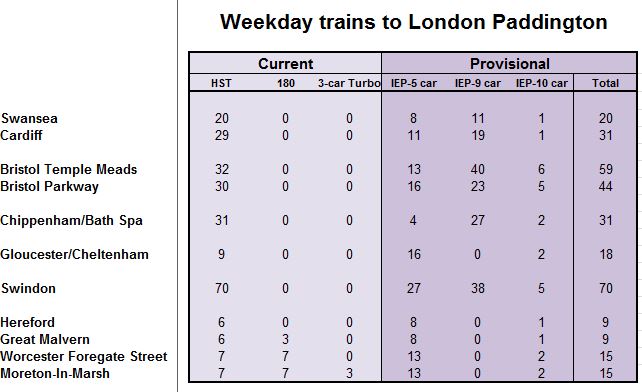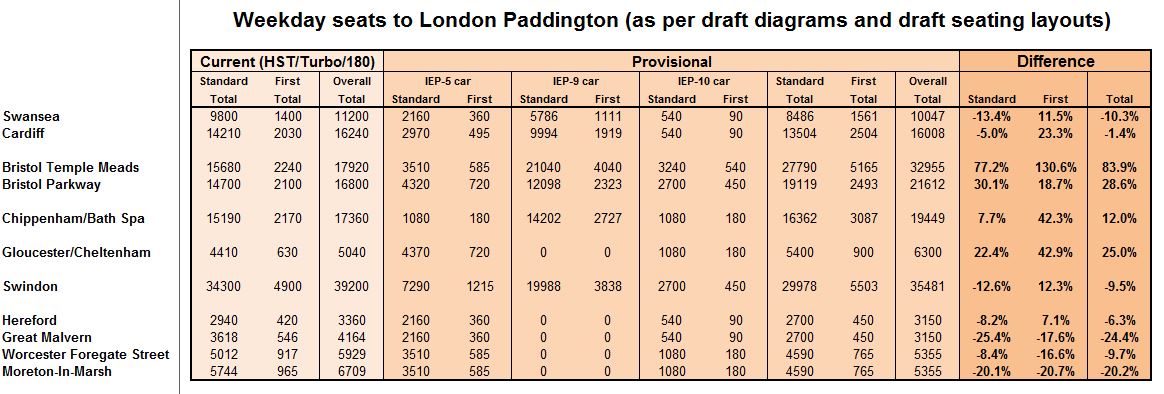Having had a few free hours to play with over the last few weeks, I wanted to satisfy my own curiosity about the likely seating totals when the
IEP▸ trains are introduced in the coming years. I^d be interested to hear people^s thoughts.
Taking on board comments from other forum members predicting severe overcrowding, ^Rhydgaled^ and ^Broadgage^ to name but two, and my own concerns which are mostly on the South Wales services and the Cotswold Line, I^ve dissected the draft IEP diagrams ^Rhydaled^ kindly re-uploaded and compared them with the current timetable and stock.
Firstly I should point out that there are some
massive caveats that have to be added to the figures, but in each case I^ve used the latest actual and proposed timetables, and the latest seating layouts. For example, the
HST▸ seating is based on an average of what the situation will be after the current modifications have been completed (490 standard class seats and 70 first class). The IEP seating is based on the draft seating plans released by the
DfT» in 2012.
So, the massive caveats I referred to:
- The provisional timetables are just that. There will have to be some changes in order for them to work anyway, and I^m sure the final versions will be significantly different on many of the routes.
- The provisional seating layouts for the IEP are just that. It may well be that, in keeping with current ratios of First and Standard Class, there will be more Standard Class seats in the final layout of the trains.
- The ^whole of the day^ picture can be misleading as the number of passengers travelling varies quite considerably throughout the day. This can work in both ways ^ for example having the 06:23 Carmarthen to Paddington train running as a 5-car bi-mode will doubtless cause issues if it stayed like that given the time of day and the calling patterns, but at the same time large decreases in seating provision on the Cotswold Line are made to look worse as currently the last two trains of the day are worked by HST^s with massive over-provision of seating.
- The figures I^ve done only apply on journeys towards London on weekdays. The weekend details, and indeed weekdays from London might be significantly different, and of course it's not just about seating when it arrives at London as there are significant commuter flows to and from other stations, so if the current full 8-car HST on a chose commute, say to Bristol Temple Meads, is replaced by a 5-car Bi-Mode then problems will arise.
- Calling patterns and frequency can alter the number of passengers on board trains quite considerably, say for example, if there was a 5tph service from Swindon to London it^s not a good use of capacity if there^s a 5-car train followed in quick succession by 10-car trains and then a large gap to the next service which is another 5-car. I^ve attempted to point out such potential benefits and negatives where possible.
- I would love to have included stations such as Oxford, Didcot and Reading in the statistics, but sadly the number of trains and their type and formation is pure speculation at the moment.
What is the approximate situation ^ number of trains?The chart below shows the current and provisional number of services operating from key stations on the HST and IEP network. Some stations, such as Swansea, Cardiff, Bath, Worcester and Swindon see little improvement in the number of trains operating, and some stations see an increase such as Gloucester, Cheltenham, Bristol Parkway and Hereford. The increase from Bristol Parkway is partly tempered with two trains of the three per hour departing within two minutes of each other. Bristol Temple Meads sees a massive increase from 32 to 59 trains per day. All routes and stations see improvements in journey times, some of them quite impressive (Bristol Parkway to London in 72 minutes rather than 91, Swansea in 2h 43m compared with 3h 05m), others more modest ^ Bath is only 1-7 minutes quicker for example.
Aside from the North and South Cotswold routes, claims that most trains will be in the hands of 5-car sets prove to be largely false based on these proposed diagrams, with only 13 out of 59 trains from Bristol Temple Meads and 4 out of 31 trains from Bath/Chippenham. Those trains feature more significantly on the Swansea route though with 8 out of 20 from Swansea, 11 out of 31 from Cardiff, and 16 out of 44 from Bristol Parkway.
A large increase in through from Cheltenham/Gloucester and Hereford is most welcome, but Moreton-In-Marsh sees less services than are currently available. Swindon remains with the same number of trains, but there has been talk of extra
EMU▸ Swindon to Paddington services.
Here is the spreadsheet showing the number of trains:
 What is the approximate situation ^ number of seats?
What is the approximate situation ^ number of seats?This is where it gets interesting! Firstly, a general observation: The first class/standard class ratio appears to swing a little bit back in the favour of more first class seats if the provisional seating plans are to be believed. As it stands, all routes (except the Cotswold Line) feature a healthy increase in first class seating over what is currently provided. The provisional seating layouts were produced before the current first class reduction programme was planned, so I wonder whether a few of the first class seats will be replaced by standard class in the final layouts?
I^ll do a summary for each of the stations I^ve chosen:
Swansea & Cardiff:Both stations would see a reduction in the number of seats provided throughout the day ^ a very small reduction for Cardiff, but over 10% in the case of Swansea. This isn^t quite as bad as it sounds as 12 trains a day will run fast from Newport to Reading, so they will not be picking up further passengers at Bristol Parkway and Swindon, however I remain concerned that there will not be enough accommodation as the reduced journey times to London are bound to attract new passengers, and certain key trains (07:19 and 08:02 from Swansea for example) have been rostered as a single 5-car Bi-Mode set.
Bristol Temple Meads:The introduction of a 4tph service, two of which are routed via Bristol Parkway to give a journey time of just 84 minutes, means a huge increase in the number of daily seats to London, which isn^t far off doubling from just under 18000 to just under 33000 ^ an increase of 84%!
Bristol Parkway:Those extra Bristol Temple Meads to London trains also mean healthy increases at Parkway, despite losing some of its current trains on the South Wales route. Seating is up by a healthy 28.6% over the day, and with some of the trains coming from Bristol Temple Meads rather than Swansea it is likely there will be more seats available on those trains.
Chippenham/Bath Spa:A modest increase of 12% throughout the day with the likelihood of a further boost of seat availability given that many Bristol Temple Meads to London passengers will be on the trains routed via Parkway instead. Will that be enough to cater for increased demand?
Gloucester/Cheltenham:The route sees a healthy 25% increase in London seats, due to the direct train service frequency increasing to hourly from one every two hours, though this is partly tempered by the removal of the shuttle service to Swindon which also carries plenty of London passengers.
Swindon:Swindon sees almost a 10% reduction in seating as a result of the proposed changes. There^s a possibility of an EMU operated shuttle service operating between Swindon and Paddington to address any crowding as a result of this reduction.
Cotswold Line:My main worry is capacity on this route and the figures reveal a substantial reduction in seats at all stations, with Worcester losing 10% of what^s currently provided and Moreton-In-Marsh a whopping 20% reduction ^ though perhaps some other extra trains will be provided by Turbos? Even Hereford, which sees an increase in trains from 6 to 9 per day, sees a decrease in the total number of seats available. Partly offset by the removal of Slough calls, but I can see demand outstripping supply quite easily.
Here is the spreadsheet showing the number of seats:
 Conclusion:
Conclusion:The situation is probably slightly worse that I thought especially with regard to the South Wales routes and the Cotswold Line. Swindon also suffers, and whilst on all of these routes there are reasons why the trains won^t be as heavily loaded as there are now, I can see the extra custom that the reduced journey times and increased frequencies will have soon presenting problems if extra capacity isn^t provided.
On the brighter side, the Bristol stations and Bath Spa/Chippenham will probably have enough seating (especially from Temple Meads) to cater for quite a large amount of growth.

